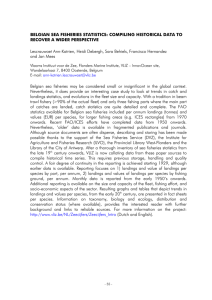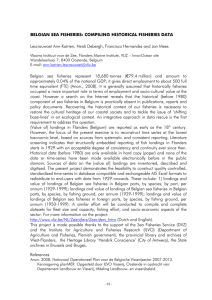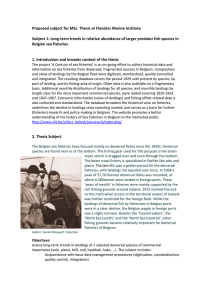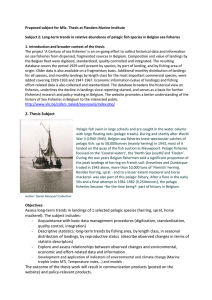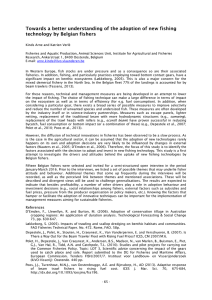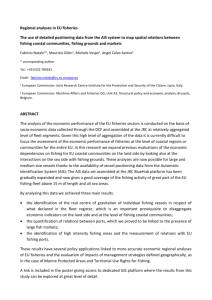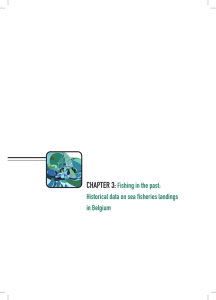Belgian fisheries: ten decades, seven seas, forty species: Historical time-series
advertisement
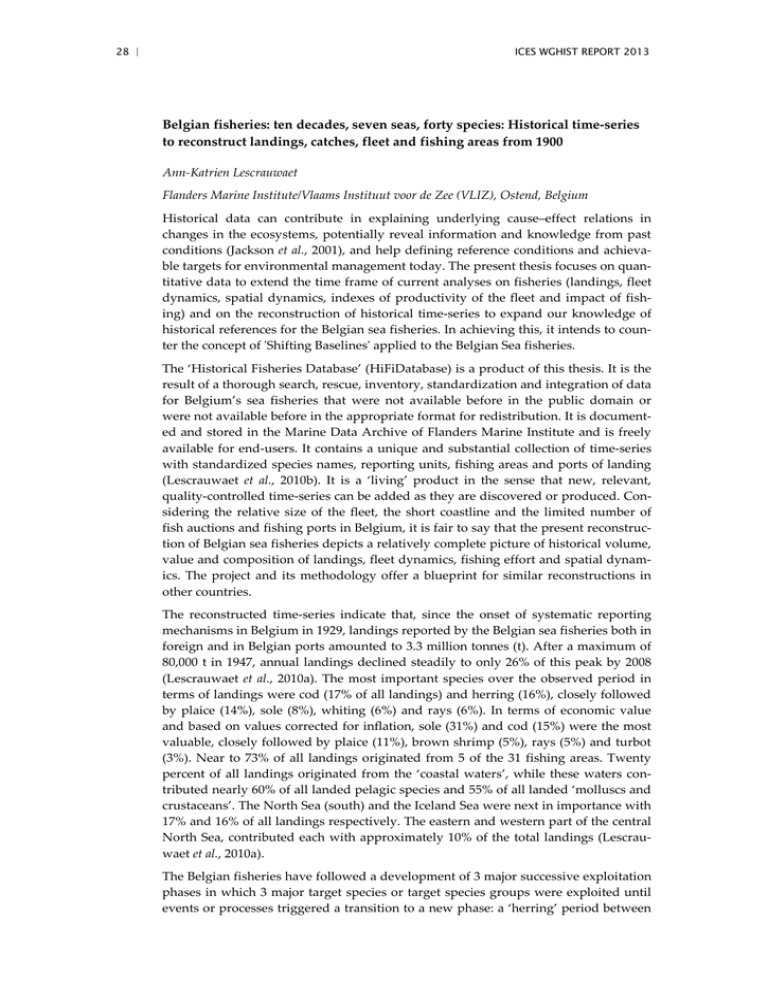
28 | ICES WGHIST REPORT 2013 Belgian fisheries: ten decades, seven seas, forty species: Historical time-series to reconstruct landings, catches, fleet and fishing areas from 1900 Ann-Katrien Lescrauwaet Flanders Marine Institute/Vlaams Instituut voor de Zee (VLIZ), Ostend, Belgium Historical data can contribute in explaining underlying cause–effect relations in changes in the ecosystems, potentially reveal information and knowledge from past conditions (Jackson et al., 2001), and help defining reference conditions and achievable targets for environmental management today. The present thesis focuses on quantitative data to extend the time frame of current analyses on fisheries (landings, fleet dynamics, spatial dynamics, indexes of productivity of the fleet and impact of fishing) and on the reconstruction of historical time-series to expand our knowledge of historical references for the Belgian sea fisheries. In achieving this, it intends to counter the concept of 'Shifting Baselines' applied to the Belgian Sea fisheries. The ‘Historical Fisheries Database’ (HiFiDatabase) is a product of this thesis. It is the result of a thorough search, rescue, inventory, standardization and integration of data for Belgium’s sea fisheries that were not available before in the public domain or were not available before in the appropriate format for redistribution. It is documented and stored in the Marine Data Archive of Flanders Marine Institute and is freely available for end-users. It contains a unique and substantial collection of time-series with standardized species names, reporting units, fishing areas and ports of landing (Lescrauwaet et al., 2010b). It is a ‘living’ product in the sense that new, relevant, quality-controlled time-series can be added as they are discovered or produced. Considering the relative size of the fleet, the short coastline and the limited number of fish auctions and fishing ports in Belgium, it is fair to say that the present reconstruction of Belgian sea fisheries depicts a relatively complete picture of historical volume, value and composition of landings, fleet dynamics, fishing effort and spatial dynamics. The project and its methodology offer a blueprint for similar reconstructions in other countries. The reconstructed time-series indicate that, since the onset of systematic reporting mechanisms in Belgium in 1929, landings reported by the Belgian sea fisheries both in foreign and in Belgian ports amounted to 3.3 million tonnes (t). After a maximum of 80,000 t in 1947, annual landings declined steadily to only 26% of this peak by 2008 (Lescrauwaet et al., 2010a). The most important species over the observed period in terms of landings were cod (17% of all landings) and herring (16%), closely followed by plaice (14%), sole (8%), whiting (6%) and rays (6%). In terms of economic value and based on values corrected for inflation, sole (31%) and cod (15%) were the most valuable, closely followed by plaice (11%), brown shrimp (5%), rays (5%) and turbot (3%). Near to 73% of all landings originated from 5 of the 31 fishing areas. Twenty percent of all landings originated from the ‘coastal waters’, while these waters contributed nearly 60% of all landed pelagic species and 55% of all landed ‘molluscs and crustaceans’. The North Sea (south) and the Iceland Sea were next in importance with 17% and 16% of all landings respectively. The eastern and western part of the central North Sea, contributed each with approximately 10% of the total landings (Lescrauwaet et al., 2010a). The Belgian fisheries have followed a development of 3 major successive exploitation phases in which 3 major target species or target species groups were exploited until events or processes triggered a transition to a new phase: a ‘herring’ period between ICES WGHIST REPORT 2013 | 29 1929 and 1950, a ‘cod’ (and other gadoid and roundfish) period between 1950 and 1980 and a period marked by plaice/sole between 1980 and 2000 (and after). This successive exploitation of targeted species was also associated with exploited fishing grounds, successively the Coastal waters for herring, the Icelandic Sea for cod, the North Sea south and the North Sea central (east and west) for sole/plaice, later also complemented by the ‘western waters’ (English Channel, Bristol Channel, Irish Sea) for the flatfish fisheries. To understand and interpret the trends in landings and changes in target species (groups), it is crucial to look at trends and changes in the fishing fleet and the fishing sector inserted in a wider socio-economic and political context. In the present thesis work, a reconstruction was made of the fleet size (from 1830), tonnage (from 1842) and engine power (kW from 1912) of the Belgian sea fisheries fleet. The time-series show an 85% decrease in fleet size and a 5% decrease in overall engine power (kW) since WWII. This decrease was compensated by a tenfold increase in average tonnage (GT) per vessel and a sixfold increase in average engine power (kW) per vessel. In only 10 years’ time after WWII, the fleet size decreased from approximately 550 to 450 vessels in 1955 (Lescrauwaet et al., 2012). Between 1955 and 1970 major structural changes took place in the Belgian sea fisheries fleet. These changes were driven first by the shift in the main fishing activities towards Icelandic waters in the 1950s and in the early 1960s by the governmental subsidies for the purchase of new steel hulled medium-sized motor trawlers and the introduction of the beam trawl (Poppe, 1977, Lescrauwaet et al., 2012). This led to less but more powerful vessels: between 1960 and 1975 the fleet size declined from 430 to approximately 250 vessels (-42%). The decline in fleet size was exacerbated when Iceland demarcated its territorial waters from 12 nm to 50 nm in 1972 and when the presence of Belgian fishers within the declared 200 nm EEZ of Icelandic waters became subject to a ‘phase-out’ in 1975 (Lescrauwaet et al. under review). As a consequence of the loss of the Icelandic waters towards 1980, Belgian vessels shifted their activities again towards the central part of the North Sea (Omey, 1982) and - to a lesser extent - towards the English Channel, Bristol Channel, South and West Ireland and the Irish Sea. From 2000 onwards specific programmes were oriented to the decommissioning of ships with the aim to reduce fleet capacity. In 2012, the Belgian commercial sea fishing fleet counted 86 ships, with a total engine capacity of 49,135 kW and gross tonnage of 15,326 GT (Roegiers et al., 2013). The reconstructed time-series suggest that total landings decreased with total fleet size and with total fishing effort. At the level of the Belgian fleet, the total number of days spent at sea decreased from approximately 91,800 days in 1938 to 15,100 days in 2010 (-84%). The landings (kg) per vessel per day at sea or per day fishing have doubled between 1938 and 2010. The time-series shows at least 4 successive events: a first event (1939–1945) marked by WWII and the increased landings of herring in coastal waters. The exceptionally high landings per unit of effort are partly explained by the cessation of large-scale herring fisheries in the North Sea during WWII combined with the effects of two strong year classes. The second period is situated in 1951–1955 and coincides with the steep increase in landings from Icelandic waters. Thirdly, an increase in landings is observed between 1960 and 1967, which coincides with the state subsidies to introduce the beam trawl first in shrimp vessels (1959-1960) and later for flatfish fisheries. A final conspicuous event concerns the period of increased levels of landings per vessel per day between 1977 and 1986. After standardization as landings per unit of installed power (LPUP) to account for the average increase (x6) of engine power per vessel, the landings have decreased by 74% from an average 1,3 t 30 | ICES WGHIST REPORT 2013 /installed kW in 1944-1947 to 0,38 t /installed kW in 2009-2010. Interestingly, the average price of landings (all species, all areas, all fisheries aggregated) is negatively correlated with the decreasing fishing effort and decrease in overall landings. This suggests that the Belgian sea fisheries compensated for the losses by targeting species that achieve better market prices. Although the LPUP are illustrative of the changes in the productivity of fisheries, they cannot be interpreted as a proxy of change in biomass of commercial fish stocks, because the Belgian fisheries have targeted different species and fishing areas over time. Trend analysis to study change in fish stocks must be conducted at the level of different métiers or fisheries, taking into account issues such as specificity and selectivity of gear, environmental conditions in the targeted fishing area, seasonality of fishing and behaviour of target species. In the thesis, a closer look was taken at the impact of sea fisheries. In a first part, a quantitative approach was taken to reconstruct total removals by Belgian sea fisheries by including the unreported and misreported landings of commercial and recreational fishing, as well as an estimation of discards. The methodology applied in this reconstruction can serve as a blueprint for similar reconstructions in other countries. The results are useful to inform current policy issues and societal challenges. This reconstruction covers 6 fisheries with historical or current importance for Belgium (Lescrauwaet et al., 2013). Total reconstructed removals were estimated at 5.2 million t or 42% higher than the 3.7 million t publicly reported over this period. Unreported landings and discards were estimated to represent respectively 3.5% (0.2 million t) and 26% (1.3 million t) of these total reconstructed removals. During the WWII, the Belgian fisheries benefited a tenfold increase in catches and fivefold increase in LPUE of North Sea ‘Downs’ herring. In the present thesis, these increased catches were explained by the combined effects of a major increase in catch power after WWI, the effects of the cessation of large-scale herring fisheries in the central part of the North Sea and by the effects of strong pre-WWII year classes (Lescrauwaet et al. revised manuscript under review). A third subchapter focused on the otter trawl fishery in Icelandic waters targeting cod. This fishery was of great economic importance in Belgium but decreased with the ‘cod wars’ (1958 and 1972) coming finally to a complete end in 1996. While the decline in total landings from Icelandic waters started after Iceland expanded its EEZ in 1958, the fishing effort of the Belgian fleet continued to increase until a peak was reached in 1963. The results show that the decline in the Iceland cod stock was visible at different levels; the decrease in the proportional importance of cod in the overall landings, the 75% decrease in the LPUE (1946-1983), the decline in the proportion of ‘large’ fish, and finally the decline or shift in the definition of a ‘large’ specimen. As a result of this thesis, unique data are presented on the trends in volume and composition of landings for the Belgian part of the North Sea (BNS). The waters of the BNS are considered as the most important fishing area in terms of source of food for local population, but also as the most stable provider of food. The BNS and in particular the ecosystem of shallow underwater sandbanks is also important as (post)spawning and nursery area (Leloup and Gilis, 1961; Gilis, 1961; Leloup and Gilis, 1965; Rabaut et.al., 2007). The HiFiDatabase broadens the historical view on fisheries and serves as a basis for a range of potential research, management applications, and in support of policymaking. In particular, the time-series provide unique historical reference conditions of fishing in the Belgian part of the North Sea and a potential baseline for fisheries management in territorial waters or for the coastal fisheries. The latter is useful in the context of the EU Marine Strategy Framework Directive, the EU Habitat Directive ICES WGHIST REPORT 2013 | 31 and the proposal for Maritime Spatial Planning on the Belgian part of the North Sea. Finally in the present thesis work, important efforts were dedicated to approach the history of fisheries from different disciplines of work. The results underline the importance of collecting economic data, inventorying historical archives and historical legislation, historical economy and politics, in order to improve the interpretation and analysis of results. As advocated by the current integrated policies for the marine environment, both the challenge of the task and the richness of the results rely on a multidisciplinary approach. References Lescrauwaet, A.-K. 2013. Belgian fisheries: ten decades, seven seas, forty species: Historical time-series to reconstruct landings, catches, fleet and fishing areas from 1900. PhD Thesis. Ghent University.
